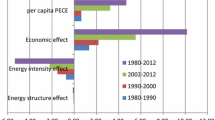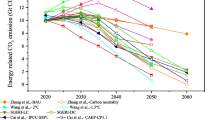Abstract
China achieved the reduction of CO2 intensity of GDP by 45% compared with 2005 at the end of 2017, realizing the commitment at 2009 Copenhagen Conference on emissions reduction 3 years ahead of time. In future implementation of the “13th Five-Year Plan (FYP),” with the decline of economic growth rate, decrease of energy consumption elasticity and optimization of energy structure, the CO2 intensity of GDP will still have the potential for decreasing before 2020. By applying KAYA Formula decomposition, this paper makes the historical statistics of the GDP energy intensity decrease and CO2 intensity of energy consumption since 2005, and simulates the decrease of CO2 intensity of GDP in 2020 and its influences on achieving National Determined Contribution (NDC) target in 2030 with scenario analysis. The results show that China’s CO2 intensity of GDP in 2020 is expected to fall by 52.9%–54.4% than the 2005 level, and will be 22.9%–25.4% lower than 2015. Therefore, it is likely to overfulfill the decrease of CO2 intensity of GDP by 18% proposed in the 13th FYP period. Furthermore, the emission reduction potentiality before 2020 will be conducive to the earlier realization of NDC objectives in 2030. China’s CO2 intensity of GDP in 2030 will fall by over 70% than that in 2005, and CO2 emissions peak will appear before 2030 as early as possible. To accelerate the transition to a low-carbon economy, China needs to make better use of the carbon market, and guide the whole society with carbon price to reduce emissions effectively. At the same time, China should also study the synergy of policy package so as to achieve the target of emission reduction.
Similar content being viewed by others
References
UNFCCC (United Nations Framework Convention on Climate Change). The Paris Agreement. 2018-06-11, available at UNFCCC website
National Bureau of Statistics of China. China Statistical Abstract. Beijing: China Statistics Press, 2018 (in Chinese)
World Bank. World Bank Database. 2018-06-19, available at World Bank website
The 13th Five-Year Plan for Economic and Social Development of the People’s Republic of China. Beijing: People’s Publishing House, 2016 (in Chinese)
Yuan J H, Xu Y, Hu Z, Zhao C, Xiong M, Guo J. Peak energy consumption and CO2 emissions in China. Energy Policy, 2014, 68: 508–523
Zhou W, Mi H. Calculation on energy-related CO2 emissions in China (2010-2050). China Environmental Science, 2010, 30(8): 1142–1148 (in Chinese)
Hao Y, Wei Y M. When does the turning point in China’s CO2 emissions occur? Results based on the Green Solow model. Environment and Development Economics, 2015, 20(6): 723–745
Li J F, Ma Z Y, Zhang Y X, Wen Z C. Analysis on energy demand and CO2 emissions in China following the Energy Production and Consumption Revolution Strategy and China Dream target. Advances in Climate Change Research, 2018, 9(1): 16–26
Mi Z F, Wei Y M, Wang B, Meng J, Liu Z, Shan Y, Liu J, Guan D. Socioeconomic impact assessment of China’s CO2 emissions peak prior to 2030. Journal of Cleaner Production, 2017, 142: 2227–2236
Li F F, Xu Z, Ma H. Can China achieve its CO2 emissions peak by 2030? Ecological Indicators, 2018, 84: 337–344
Liu Q, Gu A L, Teng F, Song R, Chen Y. Peaking China’s CO2 emissions: trends to 2030 and mitigation potential. Energies, 2017, 10(2): 209
Li N, Zhang X L, Shi M J, Zhou S. The prospects of China’s long-term economic development and CO2 emissions under fossil fuel supply constraints. Resources, Conservation and Recycling, 2017, 121: 11–22
Li L, Lei Y L, He C Y, Wu S, Chen J. Prediction on the peak of the CO2 emissions in China using the STIRPAT model. Advances in Meteorology, 2016: 1–9
He J K. Economic analysis and effectiveness evaluation on China’s CO2 emission mitigation target. Studies in Science of Science, 2011, 29(1): 14–17 (in Chinese)
He J K. Analysis of CO2 emissions peak: China’s objective and strategy. Chinese Journal of Populations Resources and Environment, 2014, 12(3): 189–198
Lin B Q, Yao X, Liu X Y. China’s energy strategy adjustment under energy conservation and carbon emission constraints. Social Sciences in China, 2010, 2: 91–110
Department of Energy Statistics, National Bureau of Statistics, People’s Republic of China. China Energy Statistical Yearbook 2017. Beijing: China Statistics Press, 2018 (in Chinese)
National Bureau of Statistics of China. China Statistical Yearbook 2017. Beijing: China Statistics Press, 2017. (in Chinese)
Deng Z, Li D Y, Pang T, Duan M. Effectiveness of pilot carbon emissions trading systems in China. Climate Policy, 2018, 18(8): 992–1011
National Energy Administration, National Development and Reform Commission. Circular on the issuance of the 13th five-year plan for energy development. 2016-12-26, available at National Energy Administration website (in Chinese)
Lin WB. Handbook of Key Energy Data 2017. Beijing: Economy & Management Publishing House, 2017 (in Chinese)
He J K. Situations of global climate governance and strategies of China’s low carbon development. Journal of China University of Geosciences (Social Sciences Edition), 2017, 17(5): 1–9 (in Chinese)
Acknowledgements
This work was supported by the National Key Research and Development Program of the Ministry of Science and Technology “Carbon emissions reduction potentials and economic costs of major countries” (Grant No: 2017YFA0605302), the National Natural Science Foundation Major Project “International Climate Governance and Cooperation Mechanism Research” (Grant No: 71690243), and Humanities and Social Sciences Base Major Projects of the Ministry of Education on “Research on the Peaking and Carbon Pricing Mechanism of Low Carbon Development in Cities” (Grant No: 15JJD630006).
Author information
Authors and Affiliations
Corresponding author
Rights and permissions
About this article
Cite this article
Wang, H., He, J. China’s pre-2020 CO2 emission reduction potential and its influence. Front. Energy 13, 571–578 (2019). https://doi.org/10.1007/s11708-019-0640-0
Received:
Accepted:
Published:
Issue Date:
DOI: https://doi.org/10.1007/s11708-019-0640-0




